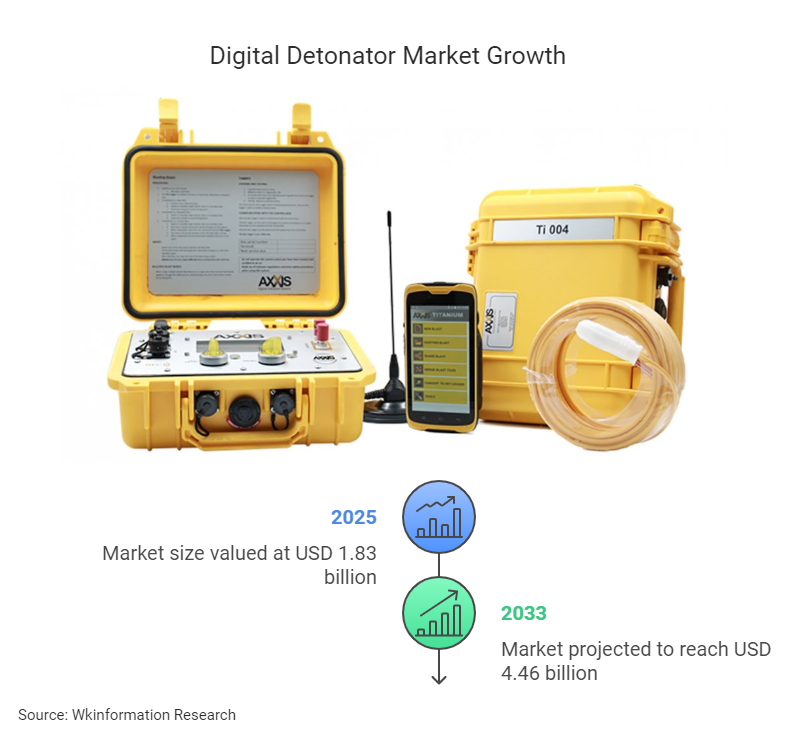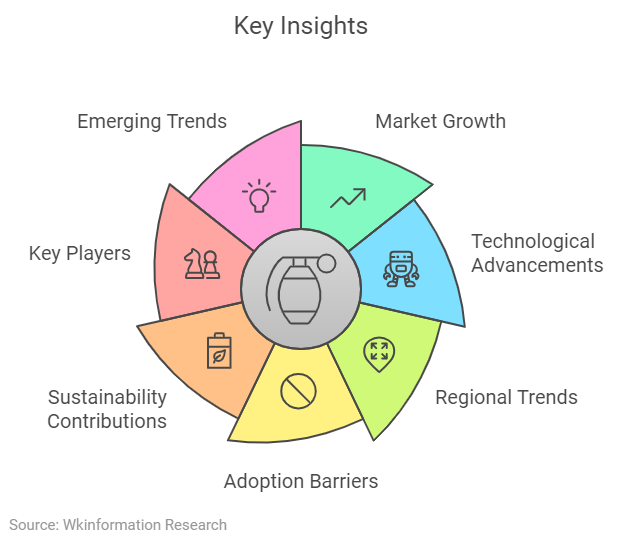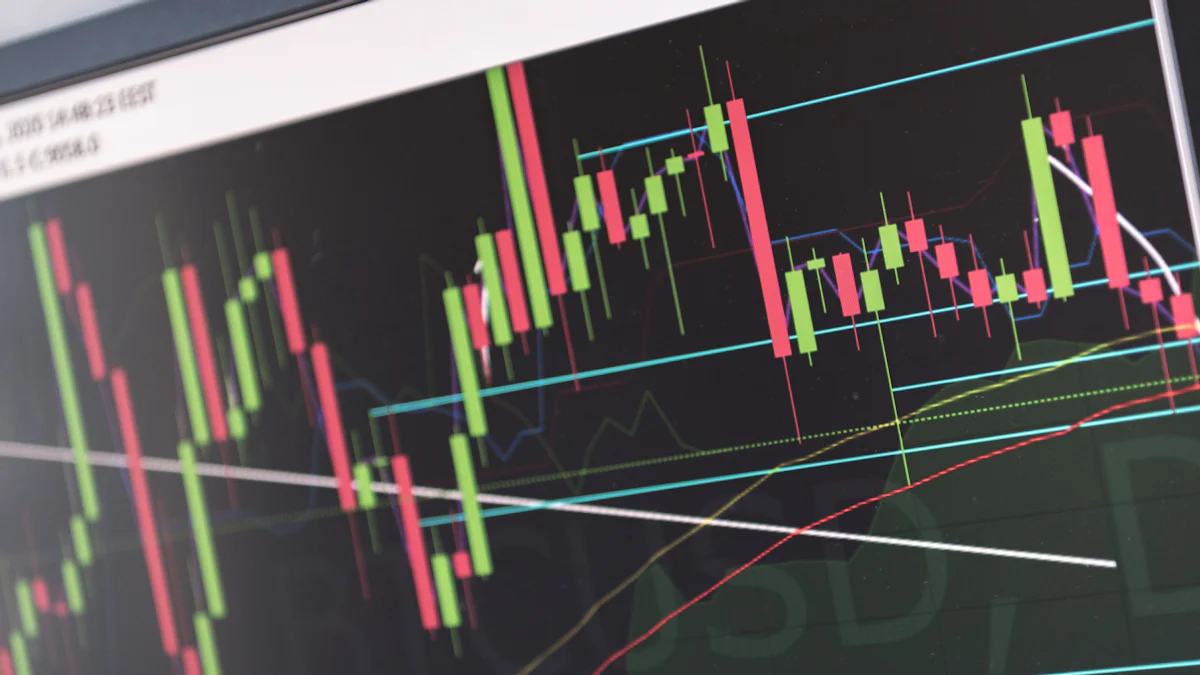
The digital detonator market plays a pivotal role in industries such as mining and construction, where precision and safety are paramount. Digital detonator technology has revolutionized blasting operations by offering enhanced control, accuracy, and reliability compared to traditional systems. These advanced blasting technologies ensure precise timing and sequencing, reducing risks and improving operational efficiency. The growing demand for safer and more efficient resource extraction methods, coupled with the need for infrastructure development, continues to drive the adoption of digital detonators globally. This shift highlights the increasing reliance on innovative solutions to meet industrial challenges.
Key Insights
- The digital detonator market is projected to grow from USD 1.83 billion in 2025 to USD 4.46 billion by 2033, driven by increasing demand for precision and safety in industries like mining and construction.
- Technological advancements in digital detonators enhance their functionality, making them more user-friendly and efficient, which is crucial for meeting modern industrial challenges.
- Asia-Pacific is the fastest-growing region for digital detonators, fueled by rapid industrialization and urbanization in countries like China and India.
- High initial costs and integration complexities are significant barriers to the adoption of digital detonators, particularly for small and medium-sized enterprises.
- Digital detonators contribute to sustainability by minimizing environmental impact and optimizing resource use, aligning with the growing emphasis on eco-friendly practices in industrial operations.
- The market is characterized by key players like Orica Limited and Dyno Nobel, who drive innovation and maintain competitive positions through advanced solutions and strategic partnerships.
- Emerging trends such as smart mining and the integration of digital technologies are shaping the future of the digital detonator market, enhancing safety and operational efficiency.

Current Market Insights
Market Size and Growth
The digital detonator market has experienced significant growth in recent years, driven by advancements in technology and increasing demand across various industries. In 2025, the market size was valued at approximately USD 1.83 billion and is projected to reach USD 4.46 billion by 2033. This expansion reflects a compound annual growth rate (CAGR) of 11.78%. The rising need for precision blasting and adherence to enhanced safety regulations has fueled this upward trajectory. Industries such as mining, construction, and demolition have embraced digital detonators to improve operational efficiency and ensure compliance with stringent safety standards.
Asia Pacific stands out as a region with remarkable growth potential. Countries like China, India, and Australia are experiencing rapid industrialization and urbanization. These developments highlight the increasing reliance on digital detonators to meet the demands of large-scale infrastructure projects and resource extraction activities.
Key Market Drivers
Several factors are propelling the growth of the digital detonator market. The demand for precision and safety in industrial applications remains a primary driver. Digital detonators offer unparalleled accuracy in timing and sequencing, which minimizes risks and enhances the effectiveness of blasting operations. This capability has made them indispensable in industries where safety and precision are critical.
The global push for infrastructure development has also played a pivotal role. Governments and private entities are investing heavily in construction and resource extraction projects, creating a surge in demand for advanced blasting technologies. Additionally, stricter safety regulations have compelled industries to adopt digital detonators, which provide better control and reliability compared to traditional systems.
Technological advancements have further accelerated market growth. Innovations in digital electronic detonators have improved their functionality, making them more user-friendly and efficient. These advancements have expanded their application scope, attracting a broader range of industries to adopt this technology.
Market Challenges
Despite its promising growth, the digital detonator market faces several challenges. High initial costs associated with digital detonator systems pose a significant barrier to adoption, particularly for small and medium-sized enterprises. These costs include not only the equipment but also the training required for operators to use the technology effectively.
Another challenge lies in the complexity of integrating digital detonators into existing systems. Many industries still rely on traditional blasting methods, and transitioning to digital systems requires substantial investment in infrastructure and workforce training. Resistance to change and lack of awareness about the benefits of digital detonators further hinder market penetration.
Regulatory hurdles also present obstacles. While stricter safety regulations drive demand, they can also complicate the approval and implementation processes for new technologies. Companies must navigate a complex web of compliance requirements, which can delay projects and increase costs.
Market Segmentation Analysis
By Type
The digital detonator market is categorized into various types, each designed to meet specific industrial needs. These types include programmable detonators, electronic detonators, and non-electric detonators. Programmable detonators have gained significant traction due to their ability to offer precise control over blast timing and sequencing. This precision enhances safety and operational efficiency, making them a preferred choice in industries like mining and construction.
Electronic detonators, another key segment, are widely recognized for their reliability and advanced features. They minimize the risk of misfires and provide enhanced accuracy, which is crucial for large-scale projects. Non-electric detonators, while less advanced, remain relevant in certain applications due to their cost-effectiveness and simplicity. This segmentation highlights the diverse requirements of industries and the tailored solutions offered by the digital detonator market.
By Application
The application-based segmentation of the digital detonator market provides insights into its widespread use across various industries. Mining remains the dominant application, driven by the need for precise and safe blasting techniques in resource extraction. Digital detonators play a critical role in optimizing mining operations by reducing waste and ensuring controlled explosions.
The construction industry also represents a significant application area. With the increasing demand for infrastructure development, digital detonators are being utilized to execute complex demolition and excavation tasks with precision. Their ability to enhance safety and efficiency has made them indispensable in urban development projects.
Other notable applications include quarrying and tunneling. In quarrying, digital detonators ensure uniform fragmentation of rocks, improving material handling and reducing costs. In tunneling, they provide the accuracy required to navigate challenging geological conditions. This broad range of applications underscores the versatility and growing importance of digital detonators in modern industries.
Regional Contributions

North America
North America has emerged as a significant contributor to the digital detonator market. The region’s well-established mining and construction industries have driven the adoption of advanced blasting technologies. The United States, in particular, leads the market due to its extensive infrastructure projects and stringent safety regulations. Companies in this region prioritize precision and efficiency, making digital detonators an essential tool for achieving operational goals.
Canada also plays a vital role in the market’s growth. Its abundant natural resources and focus on sustainable mining practices have increased the demand for digital detonators. The region’s emphasis on technological innovation further supports the integration of these advanced systems into various industrial applications.
Asia-Pacific
Asia-Pacific represents the fastest-growing region in the digital detonator market. Rapid industrialization and urbanization in countries like China, India, and Australia have fueled the demand for advanced blasting solutions. In 2025, the market size in this region projections indicating the highest compound annual growth rate (CAGR) during the forecast period.
China leads the region with its large-scale infrastructure projects and resource extraction activities. India follows closely, driven by government initiatives to enhance infrastructure and mining operations. Australia, known for its robust mining sector, continues to adopt digital detonators to improve safety and efficiency. The region’s growth trajectory highlights its pivotal role in shaping the global market landscape.
Europe
Europe holds a prominent position in the digital detonator market due to its focus on safety and environmental sustainability. Countries like Germany, Sweden, and the United Kingdom have embraced digital detonators to comply with stringent safety standards and reduce environmental impact. The region’s advanced construction and mining sectors rely on these technologies to optimize operations and minimize risks.
Germany leads the European market with its emphasis on precision engineering and technological advancements. Sweden, known for its mining expertise, has integrated digital detonators to enhance resource extraction processes. The United Kingdom contributes significantly through its infrastructure development projects, which require precise and controlled blasting techniques. Europe’s commitment to innovation and sustainability ensures its continued influence in the global market.
Market Dynamics
Drivers
The digital detonator market continues to expand due to several key drivers. Industries such as mining and construction demand advanced technologies that enhance safety and precision. Digital detonators meet these needs by offering exact control over blasting operations, reducing risks, and improving efficiency. According to industry experts, the push for safer and more precise blasting methods has made digital detonators indispensable in these sectors.
The global focus on infrastructure development further accelerates market growth. Governments and private entities invest heavily in large-scale projects, creating a surge in demand for reliable blasting solutions. Digital detonators enable complex demolition patterns, minimizing damage to surrounding structures and ensuring worker safety. Their ability to remotely detonate explosives adds another layer of security, making them a preferred choice for modern construction projects.
Technological advancements also play a pivotal role in driving the market. Innovations in digital detonator systems have improved their functionality, making them more user-friendly and efficient. These advancements expand their application across various industries, from resource extraction to urban development. The growing adoption of digital technologies in industrial operations underscores the increasing reliance on digital detonators.
Restraints
Despite its growth, the digital detonator market faces notable challenges. High initial costs remain a significant barrier, particularly for small and medium-sized enterprises. The expense of acquiring equipment and training personnel to operate these systems limits their adoption in cost-sensitive markets.
Integration complexities also hinder market penetration. Many industries still rely on traditional blasting methods, and transitioning to digital systems requires substantial investment in infrastructure and workforce training. Resistance to change and limited awareness of the benefits of digital detonators further slow the adoption process.
Regulatory compliance adds another layer of difficulty. While stricter safety standards drive demand, they also complicate the approval and implementation of new technologies. Companies must navigate complex regulatory frameworks, which can delay projects and increase operational costs. These challenges highlight the need for cost-effective solutions and streamlined integration processes.
Emerging Trends
Several emerging trends are shaping the future of the digital detonator market. The integration of digital technologies into industrial operations is one of the most significant developments. As industries adopt automation and data-driven solutions, digital detonators are becoming integral to achieving operational efficiency and safety. Their ability to provide real-time data and remote control capabilities aligns with the broader trend of digital transformation.
Sustainability is another critical trend influencing market dynamics. Industries are increasingly prioritizing environmentally friendly practices, and digital detonators contribute to this goal by reducing waste and optimizing resource use. Their precision minimizes environmental impact, making them a valuable tool for sustainable operations.
The rise of smart mining and construction practices also drives innovation in the market. Digital detonators are being integrated into intelligent systems that use sensors and analytics to optimize blasting operations. These advancements not only improve performance but also enhance safety and reduce costs. The growing emphasis on innovation and sustainability ensures that digital detonators will remain at the forefront of industrial advancements.
Competitive Landscape

Key Players in the Market
The digital detonator market features several prominent players who drive innovation and maintain competitive positions through strategic initiatives. These companies focus on delivering advanced solutions that cater to the evolving needs of industries such as mining and construction.
- Orica Limited: Orica stands out as a leader in the market, renowned for its innovative detonation systems and extensive product portfolio. The company’s flagship product, WebGen, offers precise timing and control, making it a preferred choice in mining and construction. Orica’s strong presence across North America, Europe, and Asia-Pacific underscores its global influence. Its commitment to safety and environmental sustainability further strengthens its reputation as a trusted industry leader.
- Dyno Nobel: Dyno Nobel has established itself as a key player by offering a wide range of advanced detonation systems. Its product, Dynodet, provides reliable and cost-effective solutions for various applications. The company’s emphasis on research and development, coupled with strategic partnerships, ensures its competitive edge. Dyno Nobel’s extensive distribution network and customer-centric approach enhance its ability to meet market demands effectively.
- Austin Powder: Austin Powder is recognized for its high-quality detonation systems and dedication to customer satisfaction. With decades of expertise in the explosives industry, the company delivers reliable and efficient digital detonators tailored to industrial needs. Austin Powder’s focus on safety, quality, and innovation is evident in its product offerings. Strategic collaborations with industry leaders further bolster its position in the market.
These companies exemplify the competitive nature of the digital detonator market, where innovation, safety, and customer focus are critical to success.
Market Share Analysis
The digital detonator market exhibits a dynamic competitive landscape, with key players holding significant shares due to their technological advancements and strategic initiatives. Orica Limited leads the market, leveraging its innovative products and global reach to secure a dominant position. Its focus on sustainability and precision aligns with the growing demand for advanced blasting solutions.
Dyno Nobel follows closely, benefiting from its robust research and development efforts and strong distribution network. The company’s ability to offer cost-effective and reliable solutions has enabled it to capture a substantial share of the market. Its partnerships with technology providers further enhance its competitive standing.
Austin Powder also holds a notable share, driven by its commitment to quality and customer satisfaction. The company’s expertise in the explosives industry and strategic collaborations contribute to its market presence. Its focus on delivering tailored solutions ensures its relevance in a competitive environment.
The market analysis highlights the importance of innovation, strategic partnerships, and customer-centric approaches in maintaining and expanding market share. These factors will continue to shape the competitive dynamics of the digital detonator market.
Overview
The digital detonator market demonstrates immense growth potential, driven by advancements in technology and increasing demand for precision and safety. Opportunities abound for stakeholders to explore emerging markets and develop smart detonators with enhanced safety features, remote access, and precise control capabilities. Businesses can gain a competitive edge by fostering collaborations and investing in research and development. Innovation and sustainability remain critical in shaping the market’s future, ensuring that industries continue to adopt efficient and environmentally friendly solutions. The market’s trajectory underscores its pivotal role in modern industrial operations.
| Report Attributes | Details |
|---|---|
| Base Year | 2024 |
| Market Size 2025 | 1.83 Billion USD |
| Market Size 2033 | 4.46 Billion USD |
| CAGR | 11.78% |
| Historical Year | 2019 – 2024 |
| Forecast Year | 2025 – 2033 |
| Report Coverage | Revenue Forecast, Market Competitive Landscape, Growth Factors, and Trends |
| Segments Covered | Type, Applications, and Region |
| Geographies Covered | North America, Europe, Asia Pacific, and the Rest of the World |
FAQ
What are digital detonators, and how do they differ from traditional detonators?
Digital detonators are advanced blasting devices that use electronic systems to control the timing and sequencing of explosions. Unlike traditional detonators, which rely on mechanical or non-electric methods, digital detonators offer precise control, enhanced safety features, and improved reliability. These systems reduce the risk of misfires and ensure accurate blast patterns, making them ideal for industries like mining and construction.
Why is the demand for digital detonators increasing in the mining and construction sectors?
The mining and construction industries prioritize safety and precision in their operations. Digital detonators meet these needs by providing exact control over blasting operations and minimizing risks. Additionally, stricter safety regulations and the growing complexity of infrastructure projects have driven the adoption of these advanced systems. Their ability to enhance operational efficiency and comply with safety standards makes them indispensable in these sectors.
What are the key growth drivers for the digital detonator market?
Several factors contribute to the growth of the digital detonator market:
- Technological advancements: Innovations in digital programming and wireless capabilities have improved functionality and user experience.
- Infrastructure development: Global investments in large-scale construction projects have increased demand for precise blasting solutions.
- Safety regulations: Stricter safety standards encourage industries to adopt reliable and controlled detonation systems.
- Industrialization in Asia-Pacific: Rapid urbanization in countries like China, India, and Australia has fueled market expansion.
What challenges does the digital detonator market face?
The market faces several challenges, including:
- High initial costs: The expense of acquiring digital detonator systems and training personnel can deter small and medium-sized enterprises.
- Integration complexities: Transitioning from traditional methods to digital systems requires significant investment in infrastructure and workforce training.
- Regulatory hurdles: Navigating complex compliance requirements can delay implementation and increase costs.
Which regions are leading the growth of the digital detonator market?
Asia-Pacific is experiencing the highest growth rate. Rapid industrialization and urbanization in countries such as China, India, and Australia drive this expansion. North America and Europe also play significant roles, with established mining and construction industries adopting advanced technologies to enhance safety and efficiency.
How do digital detonators contribute to sustainability?
Digital detonators support sustainability by reducing waste and optimizing resource use. Their precision minimizes environmental impact during blasting operations. Industries increasingly adopt these systems to align with environmentally friendly practices and achieve sustainable development goals.
What are the primary applications of digital detonators?
Digital detonators are widely used in:
- Mining: Ensuring precise and safe blasting techniques for resource extraction.
- Construction: Executing complex demolition and excavation tasks with accuracy.
- Quarrying: Achieving uniform rock fragmentation to improve material handling.
- Tunneling: Navigating challenging geological conditions with controlled explosions.
Who are the key players in the digital detonator market?
Prominent companies in the market include:
- Orica Limited: Known for innovative products like WebGen, offering precise timing and control.
- Dyno Nobel: Renowned for cost-effective solutions and a strong distribution network.
- Austin Powder: Recognized for high-quality detonation systems tailored to industrial needs.
These companies lead the market through technological advancements, strategic partnerships, and customer-focused approaches.
What trends are shaping the future of the digital detonator market?
Emerging trends include:
- Integration of digital technologies: Real-time data and remote control capabilities enhance operational efficiency.
- Sustainability focus: Industries prioritize environmentally friendly practices, driving demand for precise and efficient detonators.
- Smart mining and construction: Intelligent systems using sensors and analytics optimize blasting operations, improving safety and reducing costs.
What is the projected growth of the digital detonator market?
The digital detonator market is projected to grow from USD 1.83 billion in 2025 to USD 4.46 billion by 2033, with a CAGR of 11.78%. This growth reflects increasing demand for advanced blasting solutions in mining, construction, and other industries.
Global Digital Detonator Market Report – Table of Contents
1 Market Study Overview
2 Basic Product Information
3 Market Analysis
4 Digital Detonator Related Market Analysis
5 Global Trend Summary
6 Competition by Manufacturer
7 Analysis of Key Players
8 Global Digital Detonator Revenue, Sales Categorized by Regions
9 North America Digital Detonator Market Size Categorized by Countries
10 Europe Digital Detonator Market Size Categorized by Countries
11 Asia-pacific Digital Detonator Market Size Categorized by Countries
12 South America Digital Detonator Market Size Categorized by Countries
13 Middle East and Africa Digital Detonator Market Size Categorized by Countries
14 Global Digital Detonator Industry Segment Analysis
15 Global Digital Detonator Market Forecast
16 Research Findings and Conclusion
17 Appendix


